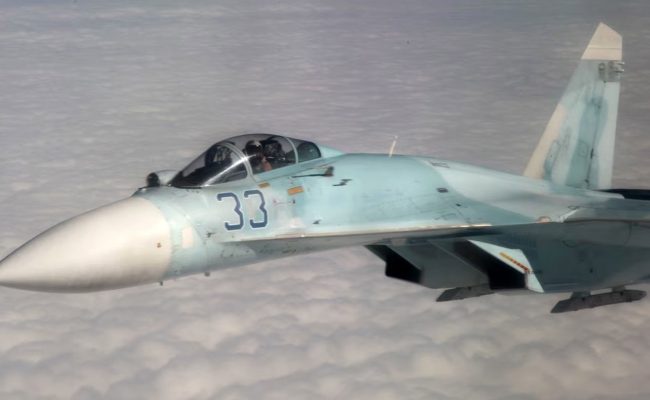Russian pilot tried to shoot down British air force jet
- Posted on
- Comment

A Russian pilot tried to shoot down an RAF surveillance plane after believing he had permission to fire, the BBC has learned.
The pilot fired two missiles, the first of which missed rather than malfunctioned as claimed at the time.
Russia had claimed the incident last September was caused by a “technical malfunction”.
The UK’s Ministry of Defence (MoD) publicly accepted the Russian explanation.
But now three senior Western defence sources with knowledge of the incident have told the BBC that Russian communications intercepted by the RAF RC-135 Rivet Joint aircraft give a very different account from the official version.
The RAF plane – with a crew of up to 30 – was flying a surveillance mission over the Black Sea in international airspace on 29 September last year when it encountered two Russian SU-27 fighter jets.
The intercepted communications show that one of the Russian pilots thought he had been given permission to target the British aircraft, following an ambiguous command from a Russian ground station.
However, the second Russian pilot did not. He remonstrated and swore at his wingman when he fired the first missile.
The Rivet Joint is loaded with sensors to intercept communications. The RAF crew would have been able to listen in to the incident which could have resulted in their own deaths.
The MoD will not release details of those communications.
Responding to these new revelations an MoD spokesperson said: “Our intent has always been to protect the safety of our operations, avoid unnecessary escalation and inform the public and international community.”
What really happened
As the two Russian SU-27s approached the RAF spy plane, they received a communication from their ground station controller.
One western source told the BBC the words they received were to the effect of “you have the target”.
This ambiguous language was interpreted by one of the Russian pilots as permission to fire.
The loose language appears to have shown a high degree of unprofessionalism by those involved, sources said. In contrast, Nato pilots use very precise language when asking for and receiving permission to fire.
The Russian pilot released an air-to-air missile, which successfully launched but failed to lock on to its target, the BBC has been told. It was a miss, not a malfunction.
Defence sources have told the BBC that a row then broke out between the two Russian pilots.
The pilot of the second SU-27 did not think they had been given permission to fire.
He is said to have sworn at his comrade, effectively asking him what he thought he was doing.
Yet the first pilot still released another missile.
We had been told that the second missile simply fell from the wing – suggesting the weapon either malfunctioned or that the launch was aborted.
What the UK MoD said happened
Three weeks later, the UK government confirmed the incident had taken place – after an explanation from the Russian Ministry of Defence called it a “technical malfunction.”
In a statement to MPs on 20 October, the then Defence Secretary Ben Wallace called it a “potentially dangerous engagement”.
But he accepted the Russian explanation, saying: “We do not consider this incident to constitute a deliberate escalation on the part of the Russians, and our analysis concurs that it was due to a malfunction.”
What the US said happened
However, a secret intelligence leak revealed that the US military spoke of what happened in more stark terms.
In a raft of documents, published online by US airman Jack Teixera, the same incident was described as “a near shoot-down”.
“The incident was far more serious than originally portrayed and could have amounted to an act of war,” the New York Times reported.
According to two US defence officials, the newspaper said, the Russian pilot had misinterpreted an order from the ground.
The Russian pilot “who’d locked on the British Aircraft, fired, but the missile did not launch properly.”
The newspaper also quoted an unnamed US defence official describing the incident “as really, really scary”.
In response to the leaked report of a “near shoot-down” the UK MoD issued another statement which added more fog than clarity.
The MoD claimed a “significant proportion of the content of these reports [from the documents] is untrue, manipulated or both”.
Why the secrecy?
There may be several reasons why the UK’s MoD was reluctant to give the full details.
First, the UK would not want to publicise the extent of its intelligence gathering and details of the intercepted communications.
More importantly neither side wanted an escalation – one which could potentially draw a Nato member into military confrontation with Russia.
But the incident does show, once again, how one mistake and miscalculation by one individual could spark a wider conflict.
The MoD has now told the BBC that “this incident is a stark reminder of the potential consequences of Putin’s barbaric invasion of Ukraine.”
This is not the first time a reckless Russian pilot has targeted a Nato aircraft in international air space.
In March earlier this year, a Russian jet brought down a US unmanned surveillance drone, also flying over the Black Sea.
In that incident the Russian pilot was awarded a medal, but most experts agree it was down to luck rather than skill or judgement.
It highlights serious questions about the discipline and professionalism of Russia’s air force.
Despite the near shoot down, the RAF has continued to conduct surveillance flights over the Black Sea – a testament to the courage of the crews who narrowly avoided a disaster.
Since the incident, these RAF surveillance flights have been escorted by Typhoon fighter jets armed with air-to-air missiles.
The UK is the only Nato ally to conduct crewed missions over the Black Sea.
-BBC






 (Selorm) |
(Selorm) |  (Nana Kwesi)
(Nana Kwesi)